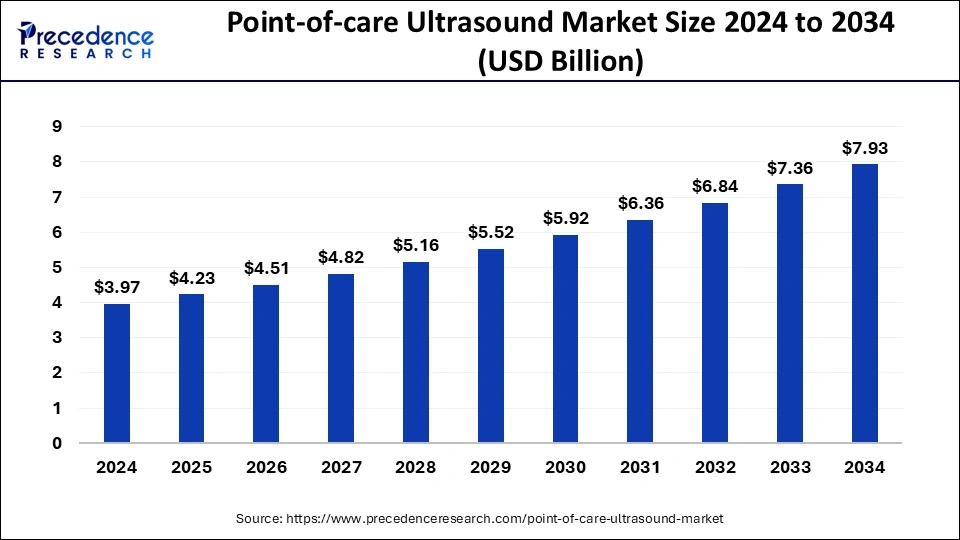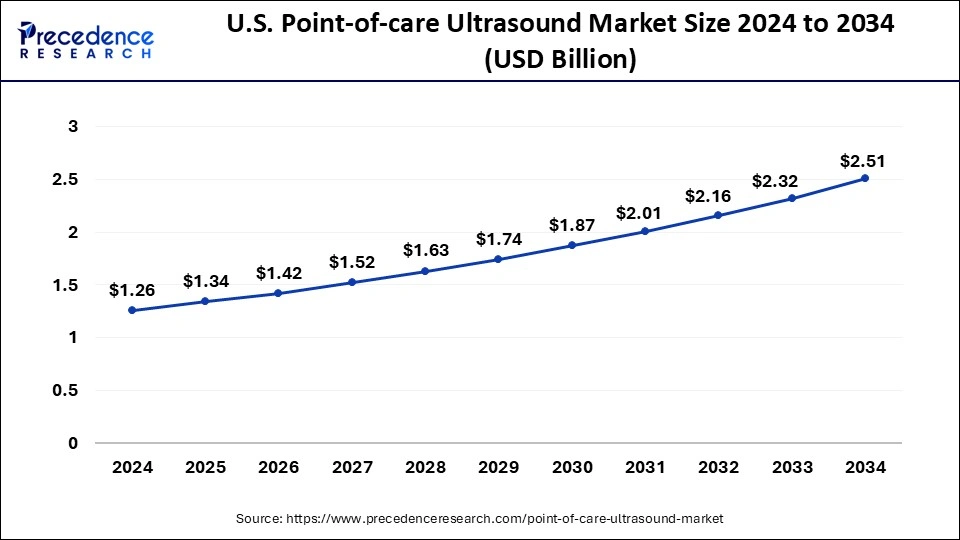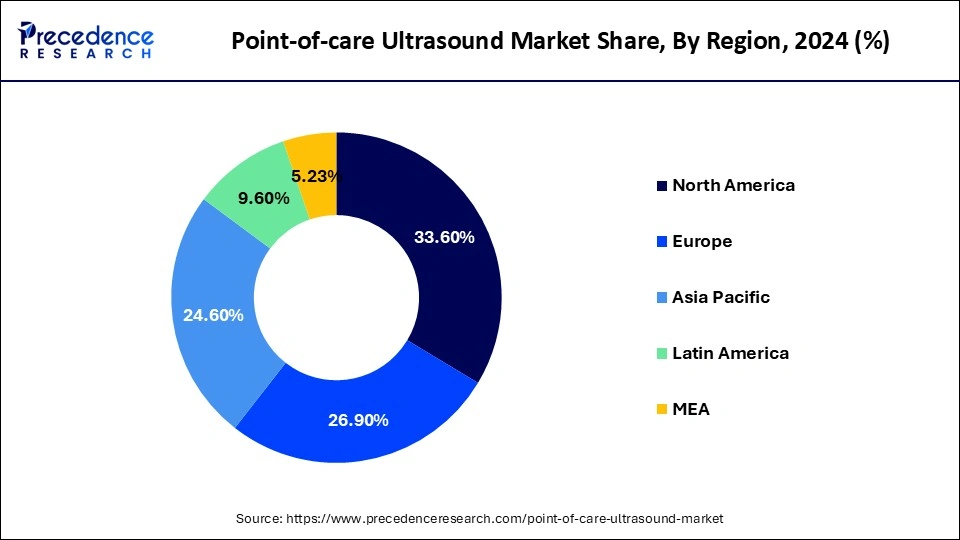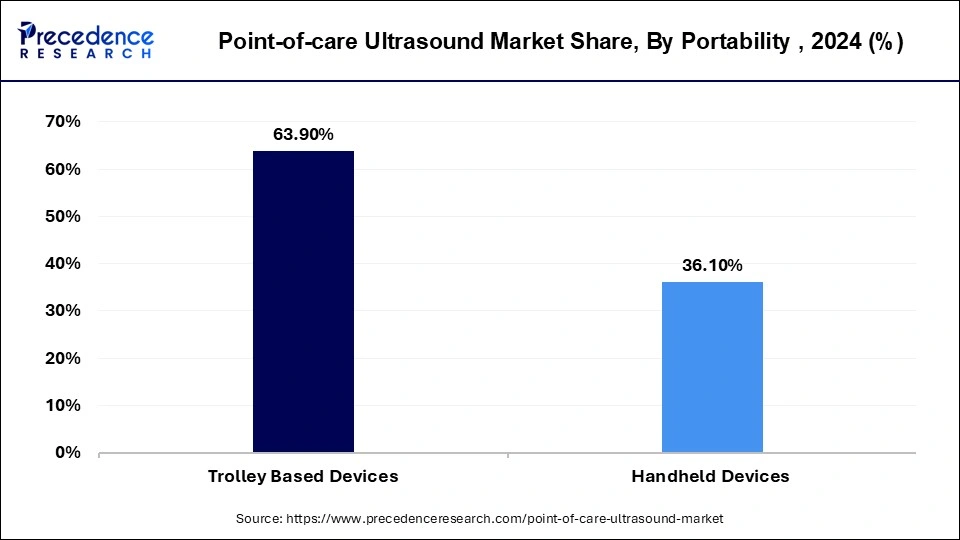May 2025
The global point-of-care ultrasound market size accounted for USD 3.97 billion in 2025 and is forecasted to hit around USD 7.93 billion by 2034, representing a CAGR of 7.20% from 2025 to 2034. The North America market size was estimated at USD 1.34 billion in 2024 and is expanding at a CAGR of 7.30% during the forecast period. The market sizing and forecasts are revenue-based (USD Million/Billion), with 2024 as the base year.
The global point-of-care ultrasound market size accounted for USD 3.97 billion in 2024 and is predicted to increase from USD 4.23 billion in 2025 to approximately USD 7.93 billion by 2034, expanding at a CAGR of 7.20% from 2025 to 2034.

The U.S. point-of-care ultrasound market size was exhibited at USD 1.26 billion in 2024 and is projected to be worth around USD 2.51 billion by 2034, growing at a CAGR of 7.23% from 2025 to 2034.

North America held the largest market share of 33.6% in 2024. The growth of the region is attributed to the presence of sophisticated healthcare infrastructure, rapid advancement of technology, rising healthcare spending, rising adoption of point of care ultrasound (POCUS) by healthcare professionals, presence of efficient reimbursement policies, increasing investment for research and development of ultrasound systems, and rising need for medical imaging due to the increasing incidence of chronic illnesses.
The United States is the major contributor to the point-of-care ultrasound market in North America. The growth of the market in the United States is driven by the presence of prominent market players, rising product approvals by various regulatory organizations, significant healthcare spending, the rising introduction of innovative and compact ultrasound devices, the increasing number of patients undergoing diagnostic screening, and the increasing prevalence of chronic diseases. Cardiovascular disorder or heart disease is one of the top causes of death among Americans.

The European point-of-care ultrasound market is expected to grow at a significant CAGR in the coming years while being the second largest marketplace due to several factors such as increasing spending for research and development in ultrasound systems, rapid adoption of technologies and presence of skilled healthcare professionals in the healthcare sector. Moreover, the rising prevalence of disorders that require continuous ultrasound imaging services propel the growth of the market in the region. Growing need for portable equipment used for diagnostic and therapeutic applications and rising strategic initiatives, along with product innovations supplement the growth of the market. the well-established healthcare sector of the region is observed to act as a major contributor to the market’s expansion.
The point-of-care ultrasound market revolves around the production, innovation and distribution of ultrasound devices that are also widely fragmented as portable ultrasound devices or handheld ultrasound devices. They are compact and relatively easy-to-use ultrasound machines. Point-of-care ultrasound (POCUS) is the practice of skilled medical professionals using ultrasound to diagnose problems. In recent years, the advancement in point-of-care ultrasound (POCUS) has gained immense popularity as it is a versatile tool for assessment, diagnosis, and follow-up in numerous fields. As a result, the developments in POCUS assist in expanding its applications and improving patient care. Portable ultrasound machines provide crisp and detailed images to facilitate real-time guidance during a procedure or provide rapid deep insights that assist clinicians in making informed decisions.
| Report Coverage | Details |
| Growth Rate from 2025 to 2034 | CAGR of 7.20% |
| Market Size in 2025 | USD 4.23 Billion |
| Market Size by 2034 | USD 7.93 Billion |
| Base Year | 2024 |
| Forecast Period | 2025 to 2034 |
| Segments Covered | Type, Portability, Application, and End users |
| Regions Covered | North America, Europe, Asia-Pacific, Latin America, and Middle East & Africa |
Rising prevalence of chronic diseases
The rising prevalence of chronic diseases across the globe has increased the demand for point-of-care ultrasound systems to diagnose the disease. POCUS devices are being used for therapeutic and diagnostic purposes across various fields such as cardiology, musculoskeletal, vascular surgery, urology, and obstetrics & gynecology. The rising prevalence of chronic diseases led to an increasing number of patients undergoing diagnostic screening due to various health conditions including severe abdominal pain, urology problems, and acute chest pain which in turn spur the demand for POCUS devices during the forecast period.
The integration of innovative technologies to offer detailed and clear images increases its adoption in various healthcare facilities. Thus, increasing incidences of chronic diseases are anticipated to fuel the growth of the point -of-care ultrasound market during the forecast period.
Lack of trained experts
The lack of skilled professionals is anticipated to projected to hamper the market's growth. The market has observed a lack of skilled professionals in underdeveloped areas. The effective use of POCUS devices requires specialized knowledge as well as training. Lack of effective training among doctors and health professionals about the safe management of POCUS devices as well as less product accessibility in middle and lower-income countries. In addition, stringent reimbursement scenarios in the healthcare sector may restrict the expansion of the point-of-care ultrasound market.
Technological advancements
Advancements in technology have led to the development of smaller, portable ultrasound devices, enabling healthcare providers to perform scans at the patient's bedside, in remote locations, or in emergency situations. This expands the potential applications of POCUS and increases its accessibility. User-friendly interfaces and automated features make modern POCUS devices easier to operate, reducing the need for extensive training. This allows a wider range of healthcare professionals, including nurses and primary care physicians, to incorporate ultrasound into their practice, thereby increasing the demand for POCUS devices. Thereby, technological advancements are observed to open lucrative opportunities for the point-of-care ultrasound market.
The diagnostics segment accounted for the largest share in 2024 and the segment is observed to sustain the position throughout the forecast period in point-of-care ultrasound market. POCUS devices play a critical role in point-of-care diagnostics by offering real-time visualization and assisting in the diagnosis of several health conditions such as cardiac abnormalities, abdominal pathologies, trauma, and others. The wide utilization of POCUS devices in maternity homes to offer diagnostic services during pregnancy creates a significant supplementary factor for the segment’s growth.
The therapeutics segment is observed to grow at a rapid pace during the forecast period. Therapeutic point-of-care ultrasound enables healthcare professionals to treat patients accurately, rapidly, and non-invasively. They are extensively used in ambulatory surgical centers, homecare settings, clinics, and hospitals. The rising demand for therapeutic devices for bedside patient health assessments to gather clinical data.
The trolley-based devices segment held the largest share of the point-of-care ultrasound market in 2024, the segment is expected to sustain the position throughout the forecast period owing to its increasing adoption of devices by hospitals and clinics in emergency medicine, vascular access and to perform other sophisticated medical tasks. The market has experienced the increasing use of trolley-based devices in emergency care rooms due to their portability from one room to the other without disrupting patient care. Such factors propel the growth of the segment.

The handheld devices segment is expected to grow significantly in the coming years owing to new product launches and rising demand for hand-held devices in various healthcare settings. Handheld devices assist healthcare professionals in optimizing healthcare operations, services, and experience. The rising popularity of mobile healthcare devices creates a significant driver for the segment to grow.
The emergency medicine segment held the largest share of the point-of-care ultrasound market in 2024 due to the increasing adoption of emergency diagnostic tools in emergency care to provide critical clinical information quickly. The ultrasound scan can be performed at the time of physical examination in a few minutes. Moreover, the rising focus on offering quality healthcare services for patients in emergency rooms create a significant growth factor for the segment.
The cardiology segment is observed to grow at a significant rate during the forecast period owing to the prevalence of cardiovascular disorders. For instance, according to the WHO, Cardiovascular diseases are the leading cause of death around the world, it is estimated that it takes 17.9 million lives each year. More than 4 out of 5 CVD deaths are due to heart attacks and strokes, and one-third of these deaths occur prematurely in people under 70 years of age. Cardiac P.O.C. ultrasound facilitates rapid real-time cardiac analysis and accurate hemodynamic profiling and properly guides patient care for better healthcare outcomes.
The hospital segment accounted for the largest share in the point-of-care ultrasound market. The growth of the segment is driven by the rising number of emergency patient visits to hospitals with mild to severe health conditions such as cardiac arrest, abdominal pain, stroke, and others. The increasing use of Point-of-care (POC) ultrasound in the hospital to offer real-time imaging-guided treatments during surgery. The hospital segment has witnessed strong demand for ultrasound imaging in emergency care and intensive care units (ICUs). In hospitals, healthcare professionals such as doctors, nurses, and radiologists are highly skilled in using this advanced device effectively for better outcomes as well as assisting them in quick decision-making processes and patient management. Such supportive factors are fueling the segment’s dominance in the market.
The clinics segment is expected to grow at a rapid CAGR due to the rising number of ultrasound tests conducted for OPD. The integration of cost-effective and technologically advanced ultrasound devices in small-scale clinics also promotes the growth of the segment.
By Type
By Portability
By Application
By End users
By Geography
For inquiries regarding discounts, bulk purchases, or customization requests, please contact us at sales@precedenceresearch.com
No cookie-cutter, only authentic analysis – take the 1st step to become a Precedence Research client
May 2025
February 2025
November 2024
October 2024